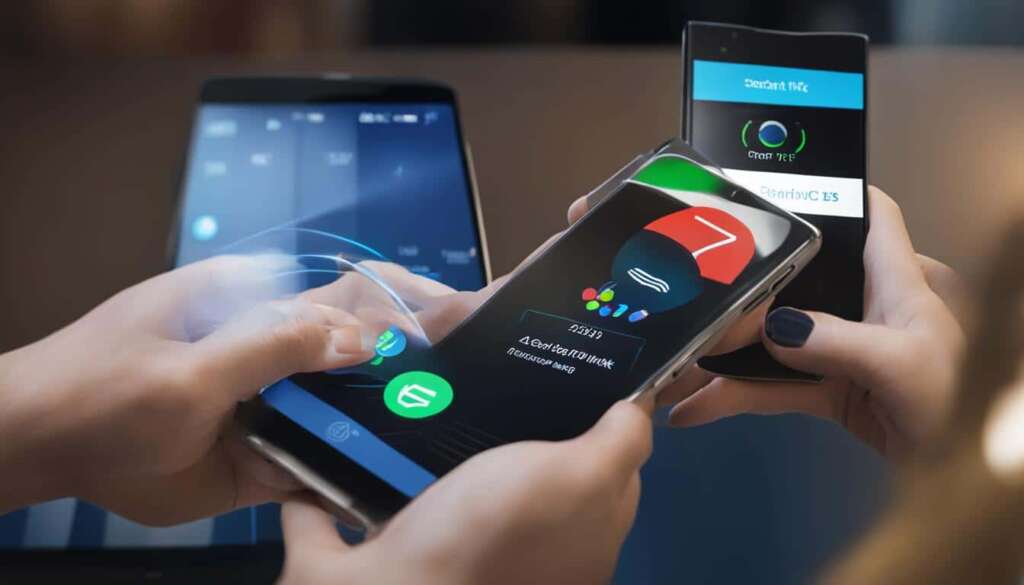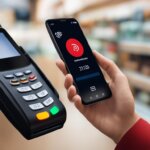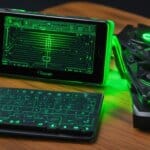Table of Contents
NFC, short for Near Field Communication, is a wireless technology that facilitates seamless communication between devices in close proximity. It enables wireless data transfer and communication between compatible devices, making it a convenient and efficient solution for various applications. With NFC technology, users can easily exchange information, make contactless payments, and access secure facilities.
NFC technology operates at a frequency of 13.56 MHz and works within a short range of approximately four centimeters. It uses radio waves to establish a connection, allowing devices like smartphones to share data with a simple touch. Whether it’s transferring files, making payments, or unlocking doors, NFC provides a quick and secure method of wireless communication.
One of the key advantages of NFC technology is its versatility. It can be used for a range of applications, including contactless payments, access control, information exchange, and more. Additionally, NFC offers intuitive communication, ensuring a seamless user experience. Its secure and interoperable nature allows for efficient and reliable data transfer.
However, it’s important to note that NFC does have its limitations. With a short operating range and slower data transfer speeds compared to other wireless technologies like Wi-Fi and Bluetooth, NFC may not be suitable for all use cases. It’s essential to consider these factors when evaluating the appropriateness of NFC for your specific needs.
In the following sections, we will dive deeper into what NFC is, how it works, its advantages and disadvantages, and its various applications. By the end of this guide, you will have a comprehensive understanding of NFC technology and its potential to enhance our daily lives.
What Is NFC (Near Field Communication)?
NFC, short for Near Field Communication, is a wireless PAN technology that allows two compatible devices to connect and enable slow but reliable data transfer. NFC operates at a frequency of 13.56 MHz and works within a short range of approximately four centimeters. NFC enables devices like smartphones to share data with a single tap, making communication fast and convenient.
The NFC standard requires both a target device and an initiator device for communication to occur. NFC technology is widely used in various applications such as contactless payments, wireless charging, key card access, and more.
In fact, NFC technology has revolutionized the way we interact with our devices and the world around us.
The Advantages of NFC Technology
“The convenience and simplicity of NFC make it an ideal choice for many everyday applications.”
NFC offers a range of benefits that contribute to its popularity and widespread use:
- Intuitive Communication: NFC enables seamless interaction between devices with just a simple touch or tap. It eliminates the need for complicated setup procedures, allowing users to connect and transfer data effortlessly.
- Versatile Applications: NFC technology can be applied to various fields and industries, including contactless payments, ticketing, identification, access control, and more. Its versatility makes it adaptable to diverse environments and scenarios.
- Secure Data Transfer: NFC incorporates built-in security features to ensure the confidentiality and integrity of data exchanged between devices. This makes it a reliable option for sensitive transactions and confidential information sharing.
- Interoperability: NFC is designed to be compatible with existing contactless card technologies, allowing for seamless integration and interoperability. This makes it easier for businesses and consumers to adopt NFC-enabled solutions.
With its user-friendly features and wide-ranging applications, NFC technology continues to shape the future of wireless communication and data transfer.
How Does NFC Work?
NFC, or Near Field Communication, operates by utilizing radio waves to facilitate communication between two devices. It functions in two distinct modes: active mode and passive mode.
In active mode, both the target device and the initiator device generate their own RF (radio frequency) fields. These devices take turns transmitting and receiving data, establishing a bidirectional connection. This mode allows for seamless and efficient data transfer between compatible NFC devices.
On the other hand, passive mode involves one device generating the RF field while the other device utilizes this field to power itself and communicate. In this mode, the powered device can transmit and receive data with the help of the active device’s RF field.
Communication between NFC-compatible devices can occur in different configurations. It can be active-to-active, wherein two active devices exchange data. It can also be active-to-passive, where an active device communicates with a passive device. Additionally, passive-to-passive communication is possible between two passive devices.
NFC technology further extends its functionality through the use of NFC tags. NFC tags are passive devices equipped with a small amount of memory. When scanned by an NFC reader, these tags can store and transfer data. They are often employed in various applications where information needs to be shared or collected.
“NFC technology enables seamless communication between devices through the power of radio waves. Its active and passive modes offer versatile options for data transfer, while NFC tags provide convenient storage and sharing capabilities.”
Example of Active Mode Communication:
Consider a scenario where a user wants to share a photo from their NFC-enabled smartphone with another NFC-compatible device, such as a tablet.
The user initiates the data transfer by selecting the photo on their smartphone. Both devices then generate their RF fields, establishing an active connection. The smartphone transmits the photo data through its RF field, while the tablet receives the data using its RF field. The devices take turns to ensure a smooth exchange of information.
Once the photo is transferred, the devices can disconnect, ending the active mode communication. The photo is now available on the tablet for viewing or further actions.
Example of Passive Mode Communication:
Let’s imagine a situation where a user wants to access details stored on an NFC tag, such as a poster in a museum.
The user approaches the NFC tag with their NFC-enabled smartphone. The NFC tag generates its RF field, serving as a power source for communication. The smartphone captures the RF field and uses it to power its NFC functionality.
With the NFC technology active on the smartphone, it can now read the data stored on the NFC tag. The information can include exhibit descriptions, historical facts, or additional multimedia content. The smartphone can then display this data to the user, enhancing their museum experience.
Advantages of NFC Technology in Various Modes:
In Active Mode:
- Efficient bidirectional data transfer between active devices
- Seamless communication and interoperability
- Secure and versatile applications
In Passive Mode:
- Ability to power and communicate with passive devices
- Convenient access to data stored on NFC tags
- Simplified information sharing and collection
| Mode | Description |
|---|---|
| Active Mode | Both target and initiator devices generate their own RF fields for communication. |
| Passive Mode | One device generates the RF field, enabling power and communication with another device. |

NFC vs. Other Wireless Technologies
When comparing NFC technology to other wireless technologies such as Bluetooth, Wi-Fi, and RFID, it is important to consider their differences in terms of range, data transfer rate, and communication capabilities.
Unlike Bluetooth and Wi-Fi, NFC operates within a much shorter range of approximately 20 cm. While Bluetooth and Wi-Fi can establish connections across distances up to 100 meters, NFC requires devices to be brought closer together for communication to occur.
Bluetooth, known for its fast data transfer rates, outperforms NFC in terms of speed. With Bluetooth, users can experience maximum data transfer rates that far surpass NFC’s relatively slower rate of 424 kbit/s.
Another distinction between NFC and other technologies is their communication capabilities. NFC enables two-way communication between devices, allowing for bi-directional data transfer. On the other hand, RFID technology, which is often compared to NFC due to its use of radio waves and tags, only allows for one-way communication.
In summary, NFC offers unique advantages such as automatic connection, faster setup time, and the capability for bi-directional data transfer. However, when it comes to range and data transfer rate, technologies like Bluetooth and Wi-Fi have the upper hand. The table below provides a clear overview of the differences between NFC, Bluetooth, Wi-Fi, and RFID.
| Technology | Range | Data Transfer Rate | Communication |
|---|---|---|---|
| NFC | Approximately 20 cm | 424 kbit/s | Bi-Directional |
| Bluetooth | Up to 100 meters | Varies, but generally faster than NFC | Bi-Directional |
| Wi-Fi | Up to 100 meters (varies depending on the setup) | Varies, but generally faster than NFC and Bluetooth | Bi-Directional |
| RFID | Varies, but generally longer than NFC | N/A | One-Way |
NFC Tags and Their Uses
NFC tags are small electronic devices that contain an antenna and a small amount of memory. They can be embedded in various physical objects like stickers, cards, or products.
NFC tags operate by sending radio waves to activate the antenna in a receiving device, allowing for data transfer and communication. These smart chips enable seamless interaction between devices and facilitate quick and convenient information exchange.
NFC tags find application in a wide range of industries and sectors, offering versatile functionality. Here are some of the common uses of NFC tags:
- Access Control: NFC tags are used to grant authorized access to buildings, vehicles, or restricted areas. They can be embedded in keycards or fobs for secure and convenient entry.
- Consumer Electronics: NFC tags are integrated into various electronic devices, such as smartphones, tablets, and smartwatches, to enable quick pairing, data transfer, and device configuration.
- Healthcare: NFC tags are utilized in healthcare settings to track medication adherence, monitor patient vitals, or provide personalized medical information to healthcare professionals.
- Payments: NFC tags enable contactless payments, allowing users to make secure transactions by simply tapping their smartphones or payment cards on NFC-enabled terminals.
- Information Collection: NFC tags can be embedded in posters, museum exhibits, or product packaging to provide additional information to users. By scanning the tags with their smartphones, users can access relevant content, such as websites, videos, or promotional offers.
These are just a few examples of how NFC tags are used. They offer a wide range of possibilities, making them a valuable tool for enhancing user experiences and enabling seamless digital interactions.
To give you a better understanding of the applications of NFC tags, here’s a table showcasing some of the industries that utilize NFC technology and the specific use cases:
| Industry | Use Cases |
|---|---|
| Retail | Inventory Management, Customer Engagement, Mobile Payments |
| Transportation | Contactless Ticketing, Smart Parking, Public Transit Passes |
| Education | Attendance Tracking, Student ID Cards, Library Management |
| Events | Access Control, Cashless Payments, Attendee Engagement |
| Advertising | Interactive Marketing Campaigns, Coupons, Loyalty Programs |
The versatility and convenience of NFC tags have made them an integral part of various industries, offering innovative solutions for diverse applications.
Benefits of NFC Technology
NFC technology offers several benefits for both consumers and businesses. With its intuitive communication capabilities, NFC enables seamless interactions between devices with a simple touch. This user-friendly approach enhances convenience and ease of use, making it effortless to establish connections and exchange information.
Moreover, NFC is a versatile technology with applications across various industries and environments. It can be employed in sectors such as healthcare, transportation, retail, and more, catering to the diverse needs of different sectors and facilitating efficient communication and data transfer.
One of the key advantages of NFC is its inherent security. NFC operates within a short range, typically around 20 cm, ensuring that data transfer occurs in close proximity. This limited range enhances security by minimizing the risk of unauthorized interception or access to sensitive information.
Additionally, NFC technology is interoperable, meaning it works harmoniously with existing contactless card technologies. This interoperability allows for seamless integration with established systems and infrastructures, providing compatibility and convenience for users.
Furthermore, NFC has the ability to facilitate the fast and simple setup of other wireless technologies like Bluetooth and Wi-Fi. By establishing a connection through NFC, users can easily pair their devices with other compatible devices, leading to a smooth and hassle-free experience.
| Benefits of NFC Technology |
|---|
| Intuitive communication |
| Versatile applications |
| Inherent security |
| Interoperability with contactless card technologies |
| Fast and simple setup of other wireless technologies |
Disadvantages of NFC Technology
While NFC technology offers many advantages, it also has some limitations and disadvantages. It’s important to consider these factors when implementing NFC in various applications.
Short Operating Range
One of the main limitations of NFC technology is its short operating range. NFC requires devices to be brought very close together, typically within a range of approximately 20 cm, for communication to occur. This means that devices need to be in close proximity, which can be inconvenient in certain situations.
Security Vulnerabilities
NFC is also prone to security vulnerabilities, such as eavesdropping. This means that malicious individuals may be able to intercept and capture data being transmitted between NFC-enabled devices. These security vulnerabilities pose a risk of data loss and unauthorized access to sensitive information.
Data Transfer Rate
Compared to other wireless technologies, NFC has a lower data transfer rate. The data transfer rate of NFC is around 424 kbit/s, which is slower than technologies like Bluetooth and Wi-Fi. This makes NFC unsuitable for transferring large files or data-heavy applications. While NFC is sufficient for smaller data exchanges, it may not meet the requirements of certain applications that involve larger data transfers.
Despite these disadvantages, NFC technology continues to evolve and improve. Developers are constantly working on enhancing its performance, security, and range to address these limitations. As NFC technology advances, it has the potential to offer even more benefits and applications in different industries.
Applications of NFC Technology
NFC technology has revolutionized various industries with its wide range of applications. One of the most popular uses of NFC is in contactless payments, where NFC-enabled devices such as smartphones allow users to make secure and fast transactions without the need for physical cards or cash. This technology provides convenience and enhances the overall shopping experience.
Another significant application of NFC is in ticketing systems. NFC-enabled tickets enable quick and hassle-free access to events, public transportation, and other venues. With a simple tap, users can enter the venue or board public transport, eliminating the need for physical tickets or cards.
NFC technology also plays a crucial role in identification and access control. It allows users to authenticate themselves and gain access to restricted areas or facilities using their NFC-enabled devices. This enhances security and simplifies the process of accessing controlled spaces.
In addition to these key applications, NFC technology is utilized in loyalty and coupon programs, enabling businesses to engage with their customers and provide personalized offers. Furthermore, NFC enables information collection and exchange, making it easier to share data between devices and access relevant content. NFC technology also finds applications in healthcare, such as tracking medication adherence, ensuring patient safety, and promoting efficient healthcare management.
FAQ
What is NFC?
NFC stands for Near Field Communication. It is a wireless PAN technology that enables slow but reliable data transfer between two compatible devices in close proximity.
How does NFC work?
NFC works by using radio waves to establish communication between two devices. It operates in two modes: active mode and passive mode. In active mode, both devices generate their own RF fields, while in passive mode, one device generates the RF field and the other uses it to power itself and communicate.
How does NFC compare to other wireless technologies like Bluetooth and Wi-Fi?
NFC operates within a much shorter range of approximately 20 cm compared to Bluetooth and Wi-Fi. NFC also has a slower data transfer rate of 424 kbit/s compared to the faster transfer rates of Bluetooth and Wi-Fi.
What are NFC tags and how are they used?
NFC tags are small electronic devices that contain an antenna and a small amount of memory. They can be embedded in various physical objects like stickers, cards, or products. NFC tags operate by sending radio waves to activate the antenna in a receiving device, allowing for data transfer and communication.
What are the benefits of NFC technology?
NFC technology offers intuitive communication and interactions, versatility in various industries, inherent security, and interoperability with existing contactless card technologies. It also facilitates fast and simple setup of other wireless technologies like Bluetooth and Wi-Fi.
What are the disadvantages of NFC technology?
NFC has a short operating range of approximately 20 cm, which requires devices to be brought very close together for communication. NFC is also prone to security vulnerabilities such as eavesdropping, and it has a slower data transfer rate compared to other wireless technologies.
What are some applications of NFC technology?
NFC technology is used in various applications such as contactless payments, ticketing systems, identification and access control, loyalty and coupon programs, information collection and exchange, and healthcare-related uses like tracking medication adherence.













